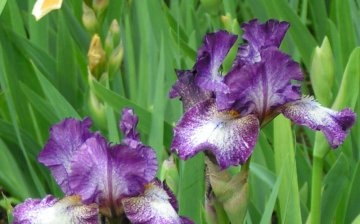Tall bearded irises: growing and grooming
We all remember from childhood irises, unpretentious flowers that were in every garden and yard, and without any care they delighted us with their annual flowering at the end of spring. Tall bearded irises are more modern varieties. Some of them are so beautiful that it is hard to believe that they are irises too. The variety of colors and shapes of flowers is striking. In addition, different varieties bloom at different times, and if you choose them correctly, you can admire the flowering for a long time. You can plant and replant irises during the entire growing season, but best of all - immediately after flowering, in July. It makes sense to plant iris only with rhizomes, since when planted with seeds, it does not retain varietal properties.
The planting unit of iris is called a delenka, it is a piece of rhizome with at least one link, a bunch of cut leaves and roots. The damaged areas of the rhizome are cut to healthy tissue and smeared with greenery. The tall bearded iris loves loose sandy loam soils and sunny areas with light shade in the afternoon, sheltered from the wind. When planting, manure must not be introduced, the rhizome will rot. It is better to plant so that the leaves are on the north side, otherwise the shadow from them will prevent the rhizome from warming up. After planting, the flowers need to be watered abundantly. In general, waterlogging is more terrible for them than drought, since the rhizomes easily rot with an excess of moisture.
It is better to water irises in the evening, and after each watering, carefully, so as not to damage the root system of the flower, loosen the soil around it. In early spring, the plant is fed with ammonium nitrate and potassium sulfate for faster growth of the green mass. During budding, a second feeding with potassium sulfate is needed so that the flowering is more abundant. After flowering, you need to remove the peduncles, tall bearded irises have a dormant period, but only 3-4 weeks. And then the rhizome begins to grow, new shoots form and flower buds are laid. At this time, it needs to be fed again with superphosphate and potassium sulfate.



